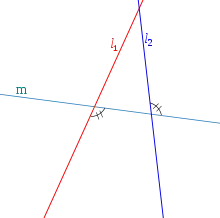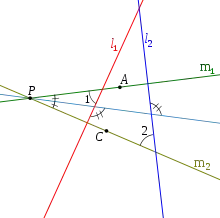In geometry, two lines and are antiparallel with respect to a given line if they each make congruent angles with in opposite senses. More generally, lines and are antiparallel with respect to another pair of lines and if they are antiparallel with respect to the angle bisector of and
In any cyclic quadrilateral, any two opposite sides are antiparallel with respect to the other two sides.
 Lines and are antiparallel with respect to the line if they make the same angle with in the opposite senses. |
 Two lines and are antiparallel with respect to the sides of an angle if they make the same angle in the opposite senses with the bisector of that angle. |
 Given two lines and , lines and are antiparallel with respect to and if . |
 In any quadrilateral inscribed in a circle, any two opposite sides are antiparallel with respect to the other two sides. |
Relations
- The line joining the feet to two altitudes of a triangle is antiparallel to the third side. (any cevians which 'see' the third side with the same angle create antiparallel lines)
- The tangent to a triangle's circumcircle at a vertex is antiparallel to the opposite side.
- The radius of the circumcircle at a vertex is perpendicular to all lines antiparallel to the opposite sides.
References
- Blaga, Cristina; Blaga, Paul A. (2018). "Directed Angles" (PDF). Didactica Mathematica. 36: 25–40.
- A.B. Ivanov, Encyclopaedia of Mathematics - ISBN 1-4020-0609-8
- Weisstein, Eric W. "Antiparallel." From MathWorld—A Wolfram Web Resource.
This article is issued from Wikipedia. The text is licensed under Creative Commons - Attribution - Sharealike. Additional terms may apply for the media files.